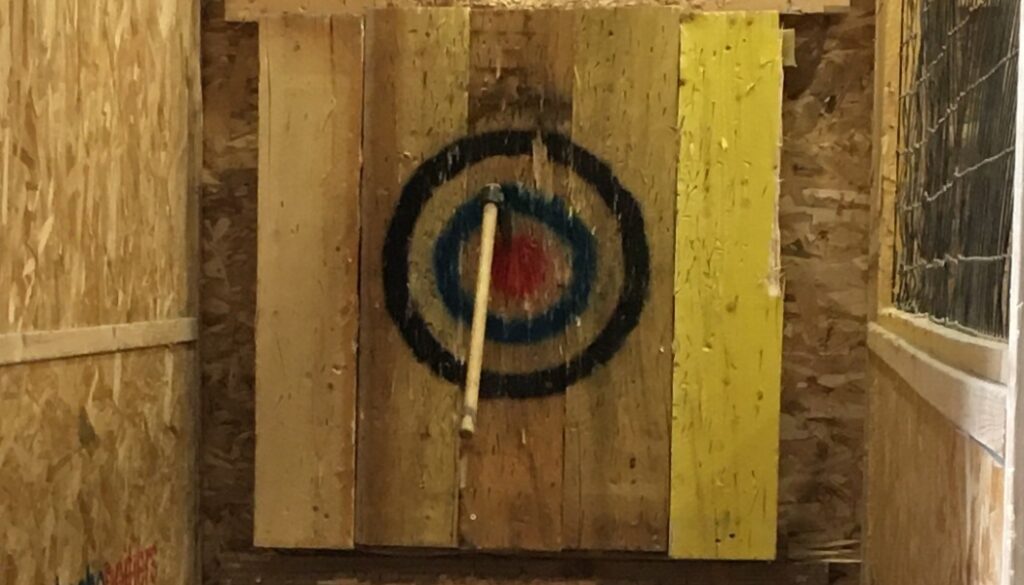The Great Target Debate. Will Planks or End-Grain Win Out?
This post explore both sides of a debate that creates a lot of consternation – planks or end-grain target?

Target construction often creates a lot of debate in contemporary axe throwing. As ever, this Bury the Hatchet feature doesn’t take sides, but simply present the facts about the two options used – planks or end-grain.
Definitions
Planks
Planks of soft wood typically 4 foot long by 10 inches wide(1.2m x 25cm), arranged in vertical strips to form a 4x4ft target. Planks are at least 1.5 inches (4cm) deep and screwed on to a supporting back board.

End-grain
Either a whole tree round, or multiple soft wood blocks (4×4 inches or larger) assembled together to form a target. The end of the grain of the wood is presented to the thrower. The rounds/blocks are about 4-6 inches (10-15cm) deep.

Debate
Planks provide a consistent surface for throwing, particularly for competitions. End-grain targets tend to be more uneven than planks. This also makes it difficult to mark a target on them directly.
Planks can be switched easily and quickly once a specific plank is damaged.
End-grain targets are regularly used both indoors and outdoors for axe throwing. They may be harder to mark, but it can be done. (Some venues will use end-grain boards in conjunction with projected targets, so there is no need to mark them).
End-grain targets will wear unevenly compared to planks, but that is part of their main advantage – they last much longer!
For example, tree rounds, more often used for outdoor throwing, last an extremely long time, and most importantly, the round remains perfectly “stick-able” until the end, as it is gradually chipped away by axe strikes.
That may be ok for general throwing, but competition needs consistency. During a competition, damaged planks can be unscrewed, removed, and replaced with a fresh plank within minutes, ensuring a fair match for all competitors.
They may be compliant, but IATF and WATL both use planks as standard in competitions. There could be an argument for not using planks with huge double bit axes, but indoor hatchet throwing is a much bigger sport and predominantly uses planks.
Any thrower who wants to compete at the highest level in these organisations would be at a disadvantage if they didn’t practise on plank targets.
Isn’t that accepting that planks are harder to stick?
It is true. When an axe hits the end-grain of the wood, it sticks more easily because the end-grain gives little resistance. It doesn’t matter whether the blade is vertical, horizontal or anything in between (as long as the axe hits at the right point of the rotation with the blade on the wood, of course). A beginner or occasional axe thrower will be able to stick the axe far more often, once they have established a basic throw.
Does it really make much sense to pick a product that is difficult to do the very thing you want? Particularly for beginners and ad hoc throwers?
End-grain targets are generally easier to stick than planks, true – which means they don’t suit hard core indoor competitors who want the challenge of planks!
Regarding beginners new to the sport, it can be easier for them to create their own target at home to try the sport out. It is easy and cheap to screw a few locally sourced planks together. It may even be possible to salvage planks for free.
Wood doesn’t need to be particularly expensive for an end-grain target, as long as it is a soft wood. Tree rounds can sometimes be obtained from forestry professionals for a small amount. They may even be free, as they can be cut from trees with less commercial value, eg Poplar.
As long as you have a connection with the forestry industry? Otherwise tree rounds are difficult to source, particularly for commercial axe throwing venues.
They can be, but end-grain blocks are created from cheap sawn soft wood. Commercial soft wood is cheap and easy to obtain as end-grain blocks.
Some people will cut up standard fence posts to create the blocks, which are mass produced and therefore cheaper still (although, as these are pressure treated they may be more difficult to dispose of after use).
Constructed end-grain targets also last a long time. Some areas of the end-grain board (eg around a bullseye) may wear more quickly than other areas (as they are made of separate blocks) and need replacing, but they still last many months with regular use.
But, end-grain blocks cost far more initially to create a single target than planks. Whether it is for a home target or for a commercial venue.
There is no denying that, but end-grain targets still last much longer, so are more cost effective in the long run.
In contrast, plank targets need to be replaced regularly (within hours for sustained use). Although cheap at outset, the amount of wood used makes it a very expensive way to build a target, and a lot of waste wood is created, which needs to be stored and disposed of.
There is a lot of waste wood with planks, but this can be used for firewood (assuming it isn’t treated).
I agree that end-grain targets may be cheaper overall, but they cost more in time and money to build and maintain.
The initial lower cost of planks and the ease of replacement make them an attractive option for commercial axe throwing venues, and as long as they prefer them, planks will remain the staple for the throwers who use them.







